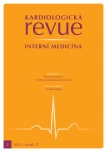-
Medical journals
- Career
Scoring systems in preventive cardiology
Authors: L. Zikmund Galková; J. Špinar; O. Ludka
Authors‘ workplace: Mezinárodní centrum klinického výzkumu, FN u sv. Anny v Brně ; Interní kardiologická klinika LF MU a FN Brno
Published in: Kardiol Rev Int Med 2015, 17(2): 112-116
Category: Cardiology Review
Overview
Cardiovascular diseases are a common cause of morbidity and mortality all over the world. Currently, cardiovascular diseases are a direct cause of death in one out of two or three patients. Hypertension as a cardiovascular risk factor was first mentioned almost 60 years ago. Since that time, multiple risk factors have been identified. Based on these factors, large population studies have been performed leading to the development of scoring systems; with the Framingham risk score being at the top. However, in our region the SCORE system is the most commonly used scoring system. Scoring systems help in finding asymptomatic patients and contribute in the management of patients with a known cardiovascular disease. Both primary and secondary prevention of fatal and non‑fatal cardiovascular events is based on cardiovascular risk stratification.
Keywords:
cardiovascular diseases – prevention – risk factors – risk estimation
Sources
1. Bitton A, Gaziano T. The Framingham Heart Study’s impact on global risk assessment. Prog Cardiovasc Dis 2010; 53 : 68 – 78. doi: 10.1016/ j.pcad.2010.04.001.
2. Ridker PM, Buring JE, Rifai N et al. Development and validation of improved algorithms for the assessment of global cardiovascular risk in women: the Reynolds Risk Score. JAMA 2007; 297 : 611 – 619.
3. DeFilippis AP, Blaha MJ, Ndumele CE et al. The association of Framingham and Reynolds risk scores with incidence and progression of coronary artery calcification in MESA (Multi‑Ethnic Study of Atherosclerosis). J Am Coll Cardiol 2011; 58 : 2076 – 2083. doi: 10.1016/ j.jacc.2011.08.022.
4. DeFilippis AP, Young R, Carrubba CJ et al. An analysis of calibration and discrimination among multiple cardiovascular risk scores in a modern multiethnic cohort. Ann Intern Med 2015; 162 : 266 – 275. doi: 10.7326/ M14 - 1281.
5. Xia Y, Xia Y, Xu K et al. Predictive value of the novel risk score BETTER (BiomarkErs and compuTed Tomography scorE on Riskstratification) for patients with unstable angina. Herz 2015; 40 (Suppl 1): 43 – 50. doi: 10.1007/ s00059 - 014 - 4141 - y.
6. Nakanishi R, Li D, Blaha MJ et al. The relationship between coronary artery kalcium score and the long‑term mortality among patients with minimal or absent coronary artery risk factors. Int J Cardiol 2015; 185 : 275 – 281. doi: 10.1016/ j.ijcard.2015.03.146.
7. Bauer M, Caviezel S, Teynor A. Carotid intima - media thickness as a biomarker of subclinical atherosclerosis. Swiss Med Wkly 2012; 142: w13705. doi: 10.4414/ smw.2012.13705.
8. Kmecová D, Rašiová M, Kozárová M et al. Vysoké členkové tlaky a kardiovaskulárna morbidita. Vask Med 2014; 6 : 24 – 26.
9. Zeb I, Budoff M. Coronary artery calcium screening: does it perform better than other cardiovascular risk stratification tools? Int J Mol Sci 2015; 16 : 6606 – 6620. doi:10.3390/ ijms16036606.
10. Conroy RM, Pyöräla K, Fitzgerald AP et al. Estimation of ten‑year risk of fatal cardiovascular disease in Europe: the SCORE Project. Eur Heart J 2003; 11 : 987 – 1003.
11. Dobiášová M. Jakou informaci poskytuje aterogenní index plazmy (AIP) o kardiovaskulárním riziku pacienta a jeho prognóze? NEUMM 2006; 1.[online] Dostupné z: http:/ / www.neumm.cz/ archiv/ 58/ jakou - informaci - poskytuje - aterogenni - index - plazmy - aip - o - kardiovaskularnim - riziku - pa-cienta - a - jeho - prognoze .html.
12. De Backer G, Ambrosioni E, Borch - Johnsen K et al. European guidelines on cardiovascular disease prevention in clinical practice. Eur Heart J 2003; 24 : 1601 – 1610.
13. Cífková R, Býma S, Češka R et al. Prevence kardiovaskulárních onemocnění v dospělém věku Společné doporučení českých odborných společností. Cor Vasa 2005; 47 (Supplementum): 3 – 14.
14. Šimon J. Úloha konvenčních a nekonvenčních rizikových faktorů v prevenci a léčebné intervenci kardiovaskulárních chorob. Postgraduální medicína 2007; 9 : 361 – 365.
Labels
Paediatric cardiology Internal medicine Cardiac surgery Cardiology
Article was published inCardiology Review

2015 Issue 2-
All articles in this issue
- Sudden cardiac death
- Scoring systems in preventive cardiology
- Scoring systems in patients with acute coronary syndrome
- Scoring systems used in atrial fibrillation
- Scoring systems for venous thromboembolic disease
- Clinical classification and scoring systems in heart failure
- Role of echocardiography in the assessment of aortic stenosis and mitral regurgitation
- Direct versus indirect methods of determining the exercise intensity in cardiovascular rehabilitation
- Scoring systems used before cardiac surgery
- Primary hyperaldosteronism – the most common form of secondary hypertension
- Cushing’s syndrome and cardiovascular risk
- Iodine saturation in Czech Republic and globally – shortcomings and perspectives
- Acute conditions in medicine of thyroid gland
- Differential diagnosis of hyponatraemia
- The Endocrinology of aging – short overview
- Cardiology Review
- Journal archive
- Current issue
- Online only
- About the journal
Most read in this issue- Clinical classification and scoring systems in heart failure
- Scoring systems for venous thromboembolic disease
- Differential diagnosis of hyponatraemia
- Acute conditions in medicine of thyroid gland
Login#ADS_BOTTOM_SCRIPTS#Forgotten passwordEnter the email address that you registered with. We will send you instructions on how to set a new password.
- Career

